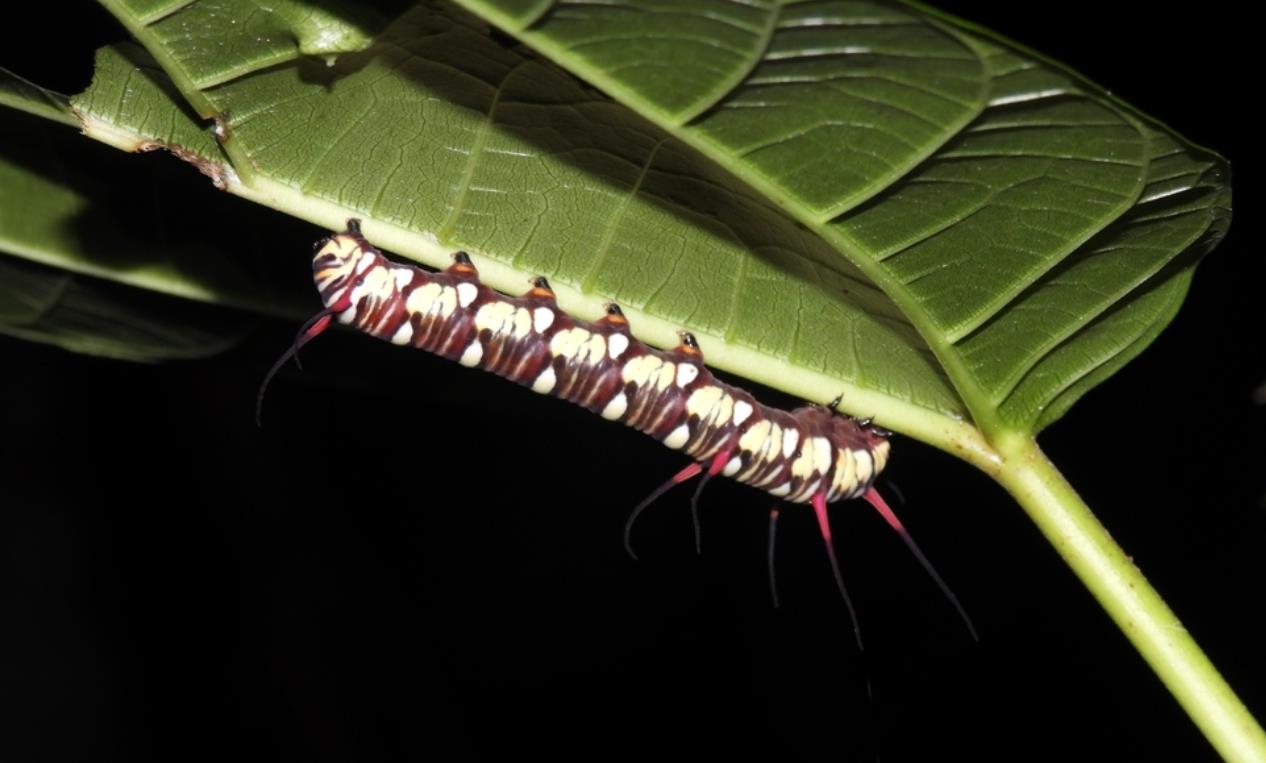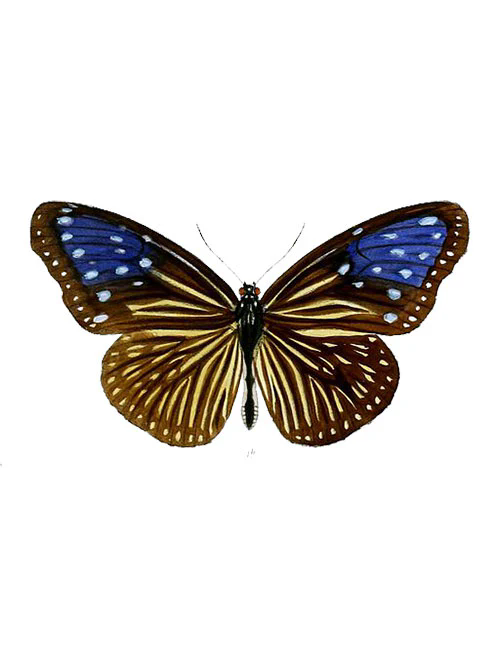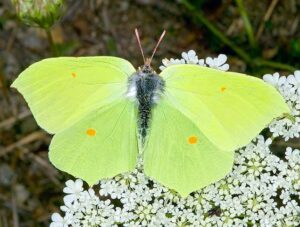
Striped Blue Crow
The common name of this species describes the female butterfly, where the hindwing is striped with narrow white streaks. The male has bright blue-shot forewings above and a reddish brown hindwing. The undersides are drably coloured with white submarginal spots.
Wingspan: 90 – 110mm.
Did you know?
The Striped Blue Crow is a common butterfly in Singapore, although not abundant. It can be found in most areas, even in urban gardens.
Euploea mulciber, the striped blue crow, is a butterfly found in India and Southeast Asia that belongs to the crows and tigers, that is, the danaid group of the brush-footed butterflies family.
Hindwing ovate. Upperside: in the male dark brown entirely glossed with brilliant blue; the following violescent white spots—a spot in apex of cell, a much curved series of five or six discal spots, a subterminal sinuous row of larger spots and an incomplete terminal series of dots. Hindwing uniform, unmarked except for a large patch of light-brown, densely set hair-like scales on the outer upper third of the wing. The female is a lighter brown, the forewing only glossed with blue on the disc; spots white, and more or less similar to those on the forewing of the male, but larger and pure white; in addition a streak in cell and another curved streak in interspace 1 showing through faintly from the underside. Hindwing: narrow white streaks in cell and in the interspaces beyond and a terminal row of slightly elongate white spots.
Underside similar to the upperside in each, but the markings broader, larger and more distinct; in the male there are besides a small white spot in apex of cell, two or three discal and incomplete sub-terminal and terminal series of white dots. Antennae, head, thorax, and abdomen dark velvety brown, the abdomen glossed with greenish blue above; beneath, the head and thorax spotted, the abdomen transversely banded with white.
Larva. “Cylindrical, with four pairs of long fleshy subdorsal filaments which have pink bases and black tips, three pairs being on the anterior segments and the fourth pair on the 12th segment. Body pinkish white with lateral yellowish blotches, the segments each divided by a black line and anteriorly bordered by a narrow transverse pink band and purple-brown stripes ; spiracles black ; head with a dark red stripe in front and one on each side ; fore legs black, middle and hind legs black ringed with pink” (Moore, Larva of the Javan form, E. claudia)
Pupa. “Short, thick across the middle; thorax concave behind; abdominal segments dorsally convex, metallic golden-brown with darker brown anterior stripe.” (Moore.) Larvae feed on Nerium indicum, N. oleander, Ichnocarpus spp., Toxocarpus wightianus, Aristolochia spp., Argyreia penangiana, Ficus spp., Ficus retusa, F. benjamina, and Ichnocarpus volubis.
Male Euploea mulciber has bright blue upperwings with white spots spreading in the distal area of the forewings, while female butterflies have blue wings with white spots embedded in the distal area and some white spots and stripes in the basal area of the forewing. The hindwings of this species are brown, in females there are additional white stripes resembling the species Ideopsis. The underside of the wings is brown with white lines or spots like the upper side.
Larva: larvae of Euploea mulciber when they hatch have a yellowish body, black legs and a large black head capsule. In the next instar phase, the caterpillars turn yellow with dark brown transverse rings interspersed with white lines in each segment of the body. The body is covered with horns on 4 segments in the dorsum area, 2 small black spots on the dorsum prothorax and one large spot on the posterior end of the body.
Pupa: Euploea mulciber pupae are initially yellowish brown, but the next day they become shiny silver, round in shape with a few small spots on the dorsum. The length of the pupa is about 19-21 mm.





The eggs of the Striped Blue Crow are laid singly on the underside of a leaf (typically young leaf) of the host plant. The creamy yellow eggs are tall (about 1.8-1.9mm in height) and somewhat cylindrical (diameter: 1.2mm) with a rounded top. The egg surface is ribbed.
The egg takes about 3 days to hatch. The young caterpillar emerges by eating away part of the egg shell. The rest of the egg shell becomes the first meal for the newly hatched, which has a length of about 3.2mm. The newly hatched has a pale yellowish body and black legs. The large head capsule is black in color. A pair of very short and inconspicuous protuberances can be found on the dorsum of each of the following four segments: 2nd and 3rd thoracic segments, the 2nd and 8th abdominal segments.
Once the newly hatched moves on to feed on the leaf lamina, its body starts to take on a green undertone. The newly hatched has this interesting habit of marking out a portion of the leaf with a series of small spots before eating away the marked out portion. In the final half day of the 1st instar, the body takes on yellowish brown transverse stripes on all segments. This instar lasts for 2-2.5 days with the the body length doubled up to 7 mm.
The body of the 2nd instar caterpillar has a yellow ground color. There are dark brown transverse rings interspersed with whitish stripes on each of the body segments except for the very 1st segment. The most obvious change is the lengthening of the 8 tiny protuberances seen in the 1st instar to short processes, each of which is almost entirely dark brown to black. There are two small black spots on the dorsum of the prothorax, and one large black patch (anal plate) on the posterior end of the body. This instar lasts only 1.5 days with the body length reaching 12mm before the moult to the 3rd instar.
The 3rd instar caterpillar is similar in appearance to the 2nd instar caterpillar with the only obvious change being the proportionally longer processes. Less obvious is the lengthening of a whitish transverse stripe on each segment to below the sub-spiracular area. In some specimens, two faint whitish lateral streaks appear on the black head capsule. This instar takes about 1.5 days to complete with body length reaching up to 16-18mm.
Compared to the 3rd instar, the 4th instar caterpillar has proportionally longer processes. On the body segments, the transverse white stripes are now prominent with one stripe being broader on the dorsum of each abdominal segment. The lower end of a white transverse stripe on each of the first seven abdominal segment is constricted to form a white triangular patch. The black head capsule features two frontal, and oblique white stripes and an outer peripheral white ring. This instar lasts 1.5 to 2 days with the body length reaching about 24-28mm.
The 5th instar caterpillar again has proportionately longer processes. An obvious change is in the basal third or quarter of each process being coloured carmine in place of dark brown/black. Another change is in the head capsule where the frontal and peripheral white stripes are now much broader and joined.The white and dark-colored transverse stripes dominate the body surface so much that the yellow coloration is only confined to the prothorax, small lateral patches and the posterior segment.
The Striped Blue Crow caterpillar, unlike the Blue Spotted Crow (E. midamus singapura) and the King Crow (E. phaenareta castelnaui), does not have an adenosma (or prostenal gland, located just ahead of the 1st pair of thoracic legs). When the caterpillar was intentionally agitated, no eversion of any structure can be seen (at the expected location) in multiple observations. The caterpillar merely adopted a head-tugged defensive stance in such occasions.
In some specimens, the colour change to carmine in the basal part of the processes also extend to the dark brown transverse stripes on the body segments and even to the head capsule. In another colour variant, the usual bright yellow coloration on body markings is replaced by a pale shade of yellow.
The 5th instar lasts for 3.5-4 days, and the body length reaches up to 51-53mm. On the last day, the caterpillar ceases feeding, and its body becomes shortened and decolorised to a shade of pale beige brown. For pupation, the caterpillar typically chooses a spot on the mid-rib of a leaf underside. At this pupation site, the caterpillar spins a silk pad from which it then hangs vertically to take on the pre-pupatory pose.
Pupation takes place 0.5 days after the caterpillar assumes the hanging posture. The pupa suspends itself from the silk pad with no supporting silk girdle. Initially, the pupa is in a light shade of yellowish brown, but the surface gradually takes on a silvery metalic glitter about a day later. The pupa is rather rotund, and has a few tiny black spots on the dorsum. Length of pupae: 19-21mm.

Three views of a fresh pupa of the Striped Blue Crow, several hours after pupation.

Three views of a shining pupa of the Striped Blue Crow, one day after pupation.

Three views of a mature pupa of the Striped Blue Crow, night before eclosion.
After about 6-7 days of development, the pupal turns black as the development within the pupal case comes to an end. The white spots on the forewing upperside become discernible through the now translucent skin. In the following morning, the adult butterfly emerges from the pupal case, and perches nearby to expand and dry its wings before taking its first flight.

A newly eclosed male Striped Blue Crow drying its wings on its pupal case.

A newly eclosed female Striped Blue Crow drying its wings on its pupal case.





Life History of the Striped Blue Crow (Euploea mulciber mulciber)
Butterfly Biodata:
Genus: Euploea Fabricius, 1807
Species: mulciber Cramer, 1777
Subspecies: mulciber Cramer, 1777
Wingspan of Adult Butterfly: 80-90mm
Caterpillar Local Host Plants: Calotropis gigantea (Asclepiadaceae, common name: Giant Milkweed), Gymnanthera oblonga (Apocynaceae, common name: Sea Rubber Vine), Nerium oleander (Apocynaceae, common name: Oleander), and various members of the Ficus genus including Ficus microcarpa (Moraceae, common name: Chinese Banyan), F. grossularioides (common name: White-leafed Fig) and F. lamponga.
Physical Description of Adult Butterfly:
Above, the male is bright blue in the forewing with diffuse white spots in the distal half; while the female is blue with embedded white spots in the distal half of the forewing and several white spots and streaks in the brown basal half. Both sexes have a brown hindwing with the female having additional narrow white streaks arranged as per the Ideopsis species. Underneath, the wings are brown with white spots/streaks arranged similarly to those on the upperside though with variation in size of the spots/streaks.
Field Observations of Butterfly Behaviour:
The sexually dimorphic Striped Blue Crow is the most common Crow species in Singapore. Though not abundant, the adults have been observed in many locations, including the nature reserves, mangrove habitats, wastelands and even in urban parks and gardens. The adults are attracted to flowers, and are easiest to approach for photo-taking when they are occupied during their flower visits.
Early Stages:
The Striped Blue Crow is polyphagous and has many larval host plants in the Moraceae, Apocynaceae and Asclepiadaceae families. The fact that it can utilize some many hosts which grow in multiple types of habitats account for its wide distribution and the common status in Singapore. The caterpillars of Striped Blue Crow feed on leaves and young shoots of the host plants, typically with the early instars focusing on young tender leaves and later instars moving on to the more mature leaves. The caterpillar has the habit of first cutting the mid-rid or the petiole of a leaf before eating the leaf lamina beyond the severed point. A web of silk threads helps to secure the severed or nearly severed part.


